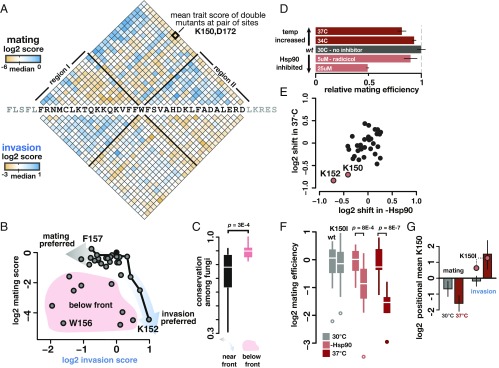Fig. 4.
Mutations residing in a region of the Ste12 DNA-binding domain increase invasion at the cost of mating, with exceptional mutations doing so in a temperature- and Hsp90-dependent manner. (A) Mean effect of double mutations between all combinations of positions for mating (above wild-type sequence) and invasion (below wild-type sequence). A specific pair of positions is shown in bold. Effects are shown as log2-fold change relative to wild-type and color-coded as in Fig. 3, functional variants in shades of blue, nonfunctional variants are shown in shades of orange. Note difference in scale ranges between mating and invasion. Black lines emanating from W156 represent boundaries of region I, in which mutations primarily reduced mating, and region II, in which mutations primarily reduced invasion. (B) Scatterplot of positional mean scores for both mating and invasion showed inverse relationship, indicating a trade-off between both traits. A point is shown for each of the 33 mutagenized positions of STE12. The trade-off is visualized as a Pareto front (black line) determined empirically from the positional data; positions near the front maintain high values for one trait and minimize costs to the other. Arrows indicate preference for either mating (gray) or invasion (blue). Positions near the front were distinguished from those below the front (shaded in red) by calculating Euclidian distances. (C) Boxplots show conservation for positions near and below the front; positions below the front are significantly more conserved among fungi than those near the front (two-sided t test). (D) Mating efficiency of yeast cells with wild-type Ste12 at increased temperature (dark red) or in the presence of Hsp90 inhibitor radicicol (pale red) is reduced relative to an untreated control (black); error bars represent SEM. (E) The mating efficiency of Ste12 variants at high temperature or with Hsp90 inhibition is shown as the shift in mean effect at each mutated position. Two positions, K150 and K152 (pale red), showed greatest sensitivity to both treatments. (F) K150I was tested in a quantitative assay to validate its temperature-sensitive and Hsp90-dependent mating activity, shown relative to wild-type (left boxplot in each pair) in each treatment (n = 20 for each sample). (G) Ste12 variants at K150 (mean effect) decreased mating (Left) and invasion (Right) at standard temperature (gray bars). At high temperature (red bars), mating further decreased; however, invasion increased. Error bars represent SEM. The K150I variant is individually highlighted for comparison.

